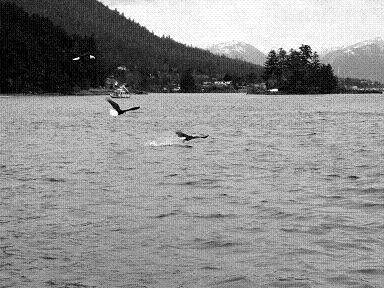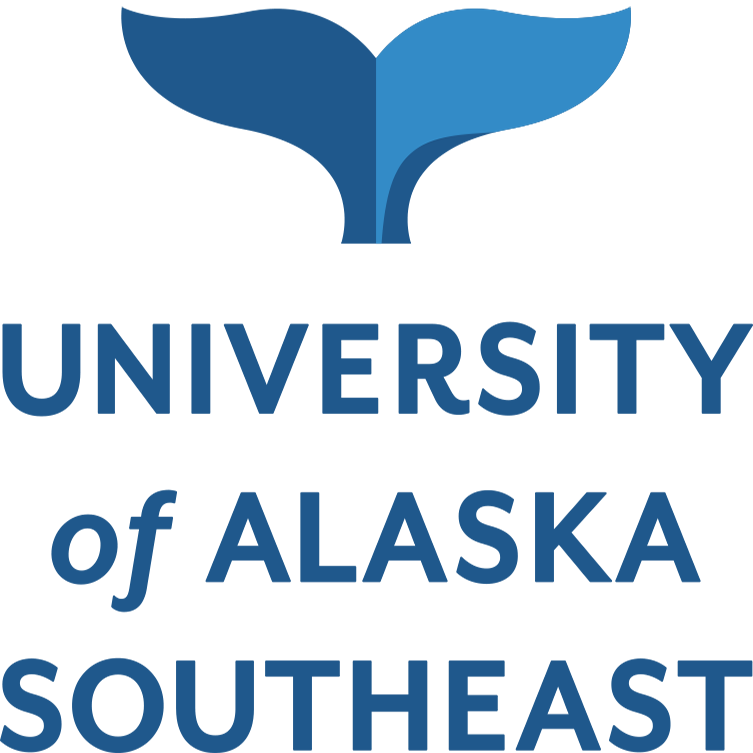Larvae Stage (0-2 Months)
Herring eggs, which Tlingit term haaw, hatch into larvae within two to three weeks of fertilization (Lasker 1985). For this reason, eggs must be gathered within a few days after spawning, before significant incubation has occurred. Because herring
typically spawn in “waves,” sometimes over a period of several weeks, not all eggs hatch at the same time. Larvae are distributed according to local current patterns, winds, and vertical migration, generally down during the day and up toward the ocean surface at night. Larvae have little capacity for propulsion in their early stages, so survival depends on their ability to ride stable currents toward relatively protected areas, such as bays and kelp patches, where they can feed and grow (Lassuy 1989). They are aided in their odyssey by a yolk-sac (McGurk 1990; Brown and Carls 1998) which provides critical nutrients and ballast during the first critical week of this vulnerable stage in the life cycle.
Tlingits refer to a special wind, the “wind of the washing of the spawn,” which typically arrives shortly after spawning and blows the fertilized eggs off the beaches and allows the herring to survive. Al Martin (Juneau), a T’akdeintaan originally from Hoonah commented: It’s called the ‘Wind of the washing of the spawn:’ L’uk’ eeti.oosk. I never heard about all the biologists talking about how the herring had to be washed clean from the beach so the herring can survive, all of the herring; but the Tlingit knew for centuries.
It was also a custom among some Tlingits to transplant eggs laid in the nonviable zones to places where they were more likely to survive, or to areas they wish to see revitalized or re-populated through “seeding.” As Harvey Kitka explains, “I believe there’s a few other people who have started to do that. … Some people are trying to take some back in Deep Inlet and other places,” effectively to restock those areas. Transplanting was also carried out on eggs considered too thinly laid for eating. Harvey Kitka further explains, “I take some of the branches … some of the thinner ones I get, and put it [in areas that need re—populating]. They claim that the herring will survive out of water for almost three days. As long as you get them back in the water they’ll, within three days, they’ll swim away.”
A variety of seabirds prey on the spawn and spawned out herring. Most voracious in the pre-hatch phase are the gulls, especially the Glaucous-winged gull. In Tlingit legend it was this gull that alerted people to the presence of spawning herring and named them. According to Herman Kitka Sr., “My dad says it was the seagulls that named that herring. ‘Yaaw’ is the noise they make when the herring’s around…that’s what the Tlingit call it: yaaw. “ As they spawn, the gulls eagerly feed on the eggs, especially those exposed by receding tide or washed or blown to shore. Thousands of gulls will collect near herring spawning areas and work the beaches, calling “yaaw.”
Post-hatch Larvae (up to 2 months)
The most successful hatchlings are those that can drift into sheltered bays or kelp patches. During the day, herring larvae often will move down toward the bottom of these refuge areas. George Dalton of Hoonah reports, “they hang out kind of at the bottom where the kelp is … there’s got to be some connection there. The kelp goes like the crab and everything else. … Yeah, you see them at the bottom.” Key food sources in these patches include invertebrate eggs, copepods, and diatoms, and larvae survival is dependent on an adequate supply of these foods and the impact of predators (Lassuy 1989).
Predation remains the biggest threat to herring once eggs have hatched. Harold Martin, originally from Kake but now living in Juneau, observes: It’s mind boggling to think how herring survive. From the time they spawn, the crows, the ravens, the seagulls, the eagles, sculpins, the trout, you know. You name it, they’re all feeding on it. And when they hatch then the ducks and everything else are--you know it’s surprising how any can come back at all. They’re just so important to the total food chain, on every animal you know, in the sea. They feed everything. They feed everything. They’re important to everything. We always—we’ve always felt—we didn’t like the idea of commercial fishermen coming in and taking them on a large scale because they’re very important to our salmon and especially king salmon, you know. And they feed our seals and stuff like that. Things that we’re depending on. This perspective was echoed by many others, who stressed the importance of herring in the marine food chain, as “being the feed for everything.” Even invertebrates, such as jellyfish, are known to feed on herring (Brown and Carls 1998).
As they mature, herring larvae eventually shed their yolk-sacs and become dependent on other food sources, particularly invertebrate eggs and zooplankton (Brown and Carls 1998). At this stage the viability and distribution of herring schools becomes more closely tied to the bounty and distribution of critical food sources, such as krill and copepods.
Finally, another major factor in herring viability at this stage of the life cycle is larval drift (Brown and Carls 1998). Unfortunate storms, winds, or currents can move herring away from refuge areas and significantly diminish their chances of survival. As Mike Miller sums up, “For the first year those little fish, especially the first six months, once they hatch out are kind of powerless to swim against currents and they get swept into the bays by the prevailing currents and so these fish that end up from Middle Island, Kasiana and stuff and these big spawns they’ll end up in Katlian, Nakwasina and places like that.”.
Juvenile Phase (2 months - 2 years)
By their third month, herring become more mobile and vagrancy increases as they begin to seek schools. Feed and protection from predators remain the critical priorities for juvenile herring. By about 10 weeks of age, larvae begin to assume adult form, though they are not sexually mature until 2-3 years of age. The importance of sheltered bays for herring rearing habitat is critical at this stage of development. As Mike Miller emphasizes, The first winter they [juveniles] spend growing up protected in little balls up in these bays. … I think it’s pretty essential that they make it up into one of those protected bays. Also, I think the predation out in the--when they get split up and out, and beat up out in the open … the survival rate is really low I guess on that. So these fish need to get up in those areas. And traditionally, I guess that, the way I understand it is that Silver Bay, the name Silver Bay comes from the young herrings that winter up there. … That’s the way it’s been told to me, that they would just look like silver on the water up there. … And it’s interesting talking with Department of Fish and Game, as they’ve done a lot of their sampling and surveys in the winter, that there does seem to be a line. They were saying at the mouth of Silver Bay that there would be adult herring and then after that line which is right about where the mill was I guess. From up, further up they’d only catch little juveniles.
Adult Schools (3+ years)
Adult schools of herring are characterized by a mixed age structure, ranging from 2-17 years, though the higher age norm is typically closer to 12 years in Southeast Alaska. Adult schools tend to range more widely than juvenile schools, according to food supplies and shelter. When they are ready to spawn in near shore waters in spring, water temperature becomes a key constraint.
Because herring are migratory and disperse and mix at different times of year under different conditions, it is difficult to distinguish between stocks. Some biologists treat all of Southeast Alaska as one genetic stock (Carls, et al 2008) but other research, based on otolith sampling, which captures unique environmental chemical signatures in the bone of the inner ear, suggests that different stocks may exist even in relatively small areas such as between Sitka Sound and Salisbury Sound on the west coast of Baranof Island (Meuret-Woody and Bickford 2009). The very concept of stocks is problematic as they can be based on a number of different criteria from genetic relationships, to life histories, to management constraints.
The diversity of age classes within a local herring population contributes to its stability and resilience.
A number of interviewees commented on the fact that adult schools follow vertical migration patterns, both within a daily cycle, going deeper in daylight and rising
to the surface in the evening. For example, Tom Mills of Hoonah remembers at Excursion Inlet in springtime, “Nighttime you could hear the water rippling with them coming to the surface. And now the only way you can see herring is set a herring net. But that’s always invaded by sea lions now.” There also is a seasonal cycle to herring vertical movements. In winter herring often lay in deeper waters, especially troughs or depressions, before moving into the shallows during spring spawning and feeding closer to the surface during the krill blooms.
Predation
Several interviewees noted that whales typically swallow herring one at a time. Whales often exhibit a pattern of “bubble feeding” when they prey on herring.
Despite the significant increase in whale numbers, most scientists do not find them to be a primary force in driving herring populations down. However, in areas where herring populations are already depressed or in trouble, whales may be having the effect of preventing rebounding (J. Straley, pers. comm. 2008).

Spawning
More than any other phase of the life cycle, we documented information on spawning behavior of herring. As noted above, this is a function of the proximity and visibility of spawning near shore and the active monitoring and interventions that occur during this phase. If learning through fishing (Pálsson 1998) is indeed a way of knowing than we should not be surprised to find a concentration of LTK in this phase.
The beginning of herring spawning is signaled by a number of factors, including tides, water temperature, light, and the “fuss” that predators make, from marine mammals to ducks, gulls, eagles, and birdlife of all sorts, to salmon and non-salmon fish, including halibut, to terrestrial mammals such as mink, and even brown bears.
Conclusion
When combined with scientific studies, LTK of herring life cycles and population ecology can play an important role in helping to understand the relationships affecting the status and health of local herring populations. In addition, LTK suggests important ways that the quality of existing spawning populations and their habitats can be conserved, and how areas of historical herring abundance might restored.




